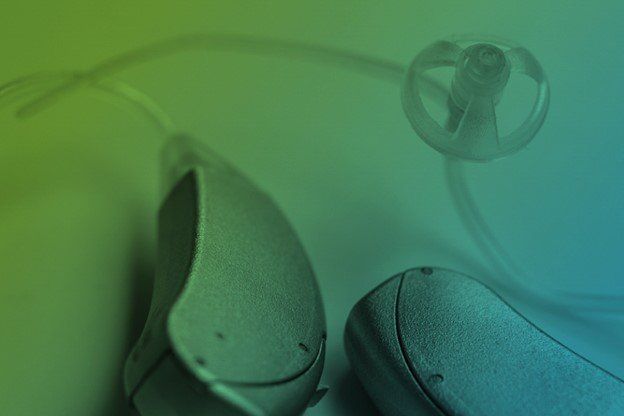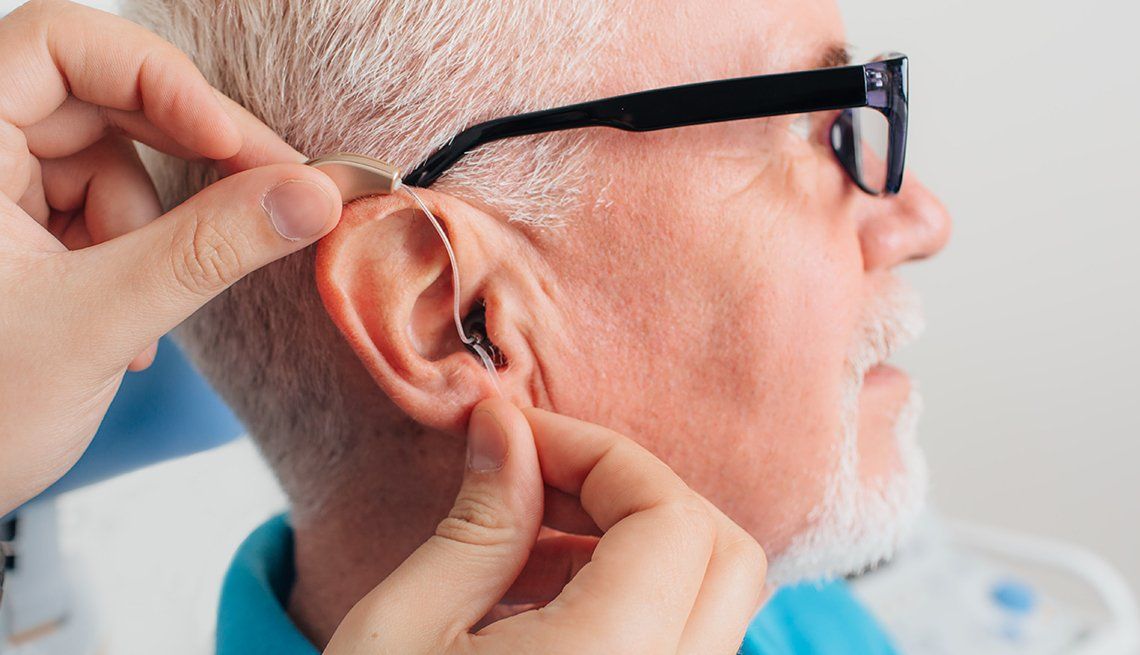Blog
Hearing Care

Rod is a very satisfied client of the Audiology Clinic of Northern Alberta. He says his life has improved significantly since he started wearing his hearing aids. Well before visiting the clinic for the first time, Rod worked in very loud environments for many years, including as a blacksmith for CP rail and in a machine shop. “It was well over the accepted noise levels,” Rod said. “Five years in the blacksmith shop and another 35 in a loud environment in a machine shop probably didn’t help me at all.” For a long time, Rod was unaware of the full level of damage that had been done to his hearing. He described it as being a progressive thing that you don’t realize until you have to confront it. “I didn’t think it was all that bad until I discovered that I was reading lips a lot. I had to see somebody's mouth if I wanted to hear everything,” Rod said. “I realized that I couldn’t hear someone if I was looking at the back of their head.” It wasn’t until he took a trip to see some of his closest friends in British Columbia that Rod understood how bad his hearing had gotten and that he needed to do something about it. “They were shocked at the amount of hearing loss I had,” Rod said. “My friend made me promise to do something about it when I got back.” “When other people are commenting, you have to take it seriously.” Rod decided to visit the Audiology Clinic of Northern Alberta, where he met Laréna (one of the clinic’s audiologists). She found that Rod had suffered significant hearing loss and that he would likely benefit from using a set of hearing aids. “The experience itself of going to see the clinic wasn’t as bad as I had imagined. It was very professional right off the bat,” Rod said. “There’s no pressure, and there’s no hard sell. It’s just getting the facts, and you run with it.” Rod appreciated that Laréna was able to explain to him in layman’s terms what was happening with his hearing, saying that it made it easier for him to accept the results and move ahead with the treatment. “She was very personable. I was able to talk to her about many things other than the service that she was providing, which is good,” Rod said. “You want to have a personal connection with someone who you’re going to be seeing off and on for a few months.” Over the course of those few months, Rod and Laréna were able to fine-tune his hearing aids to a point where he was quite satisfied with both their feel as well as their function. “Getting over the hump of the first few weeks of having foreign objects stuck in your ears, I realized that the slight discomfort that I had at first was a small price to pay, considering the amount of stress my wife had gone through for years having me repeat things over and over and over again,” Rod said. “After 2 to 3 weeks, it was hardly noticeable anymore, so I was very pleased.” Rod said that his hearing aids have offered him a significant improvement in his overall hearing and it is now much easier for him to converse with his friends and family. “I have no complaints whatsoever about the product. It’s been very good to me ever since I got it,” Rod said. “Life has improved for me quite a bit since I acquired the hearing aids, and for that I can thank Laréna and the company.”

At the centre of our approach to compassionate hearing care is taking time to listen and offer as much information as possible. Through this process, we have collected common questions about hearing aids – and questions that are not so common. The frequently asked questions about hearing aids can be grouped into the following categories: 1. Questions about costs 2. Questions about selecting hearing aids 3. Questions about technology and features 4. Questions about wearing hearing aids If your questions about hearing aids are not included in this list, book an appointment or contact us today. We’re happy to help address your questions and get you expert answers on hearing aids. Questions about hearing aid costs How much do hearing aids cost? The most common question we hear is about the cost of hearing aids. If you’ve never purchased hearing aids, it is understandable to be unfamiliar with the costs and what is included with your purchase. Like other wearable technologies, there is a wide range of costs for hearing aids: usually $1,200 to $3,600 per hearing aid ($2,400 to $7,200 for a pair of hearing aids). The top factor that contributes to cost is the level of technology, meaning the hearing aids that have the more advanced and precise usually cost more. Visit our guide to selecting hearing aids to see the difference between technology levels. What is included with the purchase of hearing aids? When you purchase your hearing aids from the Audiology Clinic of Northern Alberta, you get more than just the devices. The cost of your hearing aids also includes: Professional programming and fitting Warranty and future maintenance Support to help you get used to new hearing aids Future adjustments and reprogramming We include these ongoing services because we want your hearing aids to perform as expected through the life of the devices. Are hearing aids worth it? Untreated hearing loss can contribute to a range of impacts, including: Difficult communication Social isolation Anxiety, stress and other mental health effects Sometimes, the impacts are perceivable. But for many people, they are not aware of the effects of untreated hearing loss. For example, people with hearing loss that are working often make less money. Hearing aids are one option to treat hearing loss and reduce the negative effects. Your candidacy for hearing aids depends on your type and degree of hearing loss, in addition to other factors like lifestyle, work and overall health. To give you insight into the value that hearing aids will offer your life, our clinicians will walk through what to expect from new hearing aids. We will use the results from your hearing test to discuss how hearing aids will contribute to better hearing. Our goal is to provide as much information as possible, so you can make a confident decision about the next step. What funding is available for hearing aids? There are many funding options for hearing aids that we can help you apply for, including: Alberta Aids to Daily Living Workers’ Compensation Board Veterans’ Affairs Canada Non-Insured Health Benefits Big Stone Health Commission Private Insurance Plans Questions about selecting hearing aids Which hearing aids are best for me? The best hearing aids for you depend on your hearing loss, lifestyle and preferences. After a hearing assessment, your clinician will discuss the features you prefer and the fit you want. This gives us an understanding of your priorities. We will match the power you need according to the degree of hearing loss. The goal is to select the appropriate capabilities to assist with your hearing loss and meet your future needs (particularly if your hearing loss is progressive). From there, our clinicians will consider your lifestyle and preferences. Hearing aids are available with different features and “expressions” of sound. For example, some manufacturers are focused on designing hearing aids that sound as natural as possible. Other manufacturers prioritize technologies that help you hear someone speaking in a noisy environment (even if it doesn’t sound completely natural). Our team will take the time necessary to understand your preferences and lifestyle. We will review the benefits of various features or technologies, and then outline the options that will be the best fit for you. What types of hearing loss benefit from hearing aids? This question is best answered by our clinicians using the results of your diagnostic hearing assessment. The type of hearing loss is only one factor when considering if hearing aids are an appropriate option. What if I don’t like my new hearing aids? When you start wearing new hearing aids, they may not perform as expected or you may experience some amount of discomfort. This is normal because your body and brain need time to acclimatize to the new sounds. Here are tips for adjusting to new hearing aids , and your clinician will be available to address your concerns. We ask that you share with us any issues or problems you face with your new hearing aids. Our hearing aid trial period lets you take time to understand your devices – all with help from us. Your clinician will be available to adjust your hearing aids and let you know if what you’re experiencing is expected. We will not be satisfied until you are happy with your hearing aids. If the problems persist and you are not satisfied, you can return them for a full refund. All new hearing aids from the Audiology Clinic of Northern Alberta come with a risk-free trial period. Questions about hearing aid technology and features What are the differences in hearing aids? Hearing aids come in various styles and power levels. Depending on your degree and type of hearing loss, some styles and power levels may be more appropriate for your hearing needs. For example, people with progressive hearing loss may benefit from devices that have adequate power for the life of the hearing aids. Another difference in hearing aids is the level of technology. This describes how precise, smart or adaptable the hearing aids are. Each hearing aid manufacturer aims to create the best devices possible. Most manufacturers share similar features and technology levels, but they tend to sound a bit different. Some manufacturers prioritize natural sounds while others focus more on optimizing speech in noisy places. Your clinician can help you choose the best manufacturer for your preferences. Features like Bluetooth connectivity and rechargeable batteries are available across most devices and not linked the technology level or price. You can also choose between various colours and styles. Our guide to selecting hearing aids includes more details on the levels of technology. Which hearing aids have Bluetooth technology? Hearing aids of all technology levels can include features like Bluetooth connectivity. Some smaller custom styles may not be available with Bluetooth, but this case is rare. If Bluetooth is important to you, let us know and we can help you find the right device. Questions about wearing hearing aids What can I expect from new hearing aids? Adjusting to new hearing aids is different for everyone and often takes time. Most people adjust to their new hearing aids during the trial period. As your brain and body get used to the sound signals from increased amplification, you can expect sounds and the physical comfort to get better over time. You may encounter discomfort or exhaustion, but you should not experience pain. Your clinician will provide suggestions to streamline the process, and we are always available to help if anything unexpected arises . Do I need to wear hearing aids all the time? We recommend you wear your hearing aids as often as possible, as long as they are comfortable. It’s important to wear them regularly to help your brain get used (and stay used) to the sounds it receives from the devices. Do I need two hearing aids? Your clinician will use the results from your hearing test to recommend one or two hearing aids. For most people, two hearing aids deliver more balanced sounds and a better experience by: Aiming to restore hearing loss to normal levels Improving balance Improving hearing in noisy environment Improving localization abilities (so you can better determine where sounds are coming from) How are hearing aids adjusted? Hearing aids need to be personalized to the wearer. We will program your devices when they arrive at our clinic according to your hearing loss, and then we will verify they operate as expected while you are wearing the hearing aids. We also will objectively measure how your hearing aids are functioning using real ear measurements. This process involves testing your hearing aids while they’re in your ear. Over time, your hearing and lifestyle may change. Your clinician can review and adjust your hearing aids to align with your current needs and lifestyle. What if I have issues with my hearing aids? Start by exploring our guide to troubleshooting problems with your hearing aids . If you’re unable to resolve the issue, book an appointment at the Audiology Clinic of Northern Alberta. Get more hearing aid tips See our article on top hearing aid tips for suggestions on wearing, using and maintaining your hearing aids.

When Anthony first visited the Audiology Clinic of Northern Alberta in the early 2000’s, he came as a foreigner in need of help fixing his existing hearing aids. Eventually moving to Alberta from the United States, Anthony’s decision to continue receiving service from the clinic was an easy one to make. “I needed somebody to fix my existing hearing aids,” Anthony said. “I took them there, they fixed them, and they gave me such good service that I never left.” Anthony has made lasting relationships with some of the clinic’s team, including Laréna Lewchuk and Essie Palmer, both audiologists that have worked at the clinic since the early 2000’s. “Over the last 22 years, Essie and Laréna have both provided me with excellent service,” Anthony said. “They’re both highly skilled and good at what they do.” Anthony has been dealing with hearing loss problems since he was 17 and in school. The loss of his hearing was a hindrance in his early life. “It was impacting both education and social situations,” Anthony said. “I couldn’t hear people, so I couldn’t hear my instructors very clearly. I couldn’t hear my friends unless they were really close by me.” Anthony was impressed with the clinic’s ability to tackle his level of hearing loss. “For them to help somebody like me who has profound hearing loss, it’s quite challenging,” Anthony said. “I’m pushing my hearing aids ability to perform as hard as they can.” As hearing aid technology advances, Anthony appreciates that the Audiology Clinic of Northern Alberta made sure to keep on top of the all the latest trends. “The technology has increased quite a bit,” Anthony said. “My first set of hearing aids were analogue. Now they’re digital hearing aids, all the way to the point that now I can control my hearing aids through my phone.” Many hearing aids available today are able to do much more than just helping with hearing issues. In recent years they have become multi-purpose devices that can be highly customized to fit each individual user’s needs. “The feature that I like best about them is that they are able to stream with Bluetooth,” Anthony said. “I’m able to stream music with them, and I’m able to take a call using Bluetooth. It does it in both ears at once, which is convenient.” Anthony describes the Audiology Clinic of Northern Alberta as being a full-service shop where they will help you on every step of your hearing journey, from receiving an initial hearing test in a proper sound-proof room all the way through to adjustments and repairs, years down the line. “Probably the biggest thing you notice that you don’t see right up front is the after service,” Anthony said. “If I have a hearing aid that has a problem, they send it off to get repaired and they also loan me a hearing aid so that I’m able to keep functioning day to day. This attention and care at every step is the reason Anthony recommends the Audiology Clinic of Northern Alberta. “They have a very high level of customer service.”

The future of hearing aid technology is difficult to predict, but we eagerly watch for the latest devices and improvements introduced by manufacturers every year. Advancements in hearing aid technology are incredible to observe. With every new generation of hearing aids, there are boosts in the internal processing capabilities and new features are added that make the devices easier to operate and optimize – for both the wearer and the clinician. More importantly, newer hearing aids do a better job at matching expectations while minimizing the hurdles or annoyances that were present in previous generations. Here are the advancements in hearing aid technology that we are excited about – and what it means for your hearing. Rapid progress in hearing aid technology is normal Just like your smartphone or computer, rapid progress in hearing aid technology is not only common – but expected. Manufacturers continue to push the limits of what is possible in hearing aids, which is notable considering the challenges of hearing aid technology: Hearing aids are incredibly tiny They are expected to remain reliable and perform optimally throughout their lifetime Hearing aids must be durable and withstand regular use in places that are unfriendly to electronics (that is, your ears) They perform advanced calculations and are expected to adapt seamlessly to various environments and situations Despite these challenges, manufacturers continue to develop technology that outperforms and outlasts yesterday's hearing aids. And these changes are introduced at an incredible pace. For example, we have witnessed rapid progress in hearing aid batteries . Only a few years ago, we were hesitant to recommend rechargeable batteries. Previous generations of rechargeable batteries sacrificed processing power or would not last a full day. Today, rechargeable batteries no longer sacrifice power, and they are just as convenient as you expect. It only took a few generations to advance the technology to deliver convenient recharging, all-day power and no sacrifices to processing power. And we expect many features to continue to evolve to offer more benefits with fewer trade-offs. Future of hearing aid technology The hearing aid advancements that we are looking forward to likely won't revolutionize the technology. Instead, they will continue the ongoing evolution of the technology so hearing aids simply work better for more people. For you – this means that hearing aids will better match your hearing needs and adapt to different rooms, environments or noises. For clinicians – this means that we can better optimize your hearing aids to the specific challenges that you face. Here is what we expect from hearing aid technology as it progresses in 2022 and beyond. Improved processing power Just as computers get faster every year, so do hearing aids. Improved processing power allows hearing aids to make better decisions according to the information they receive. For example, hearing aids evaluate the signals they receive and decide how to balance the output to help you hear the sounds you want while reducing the noises you don’t want to hear. As hearing aids get quicker and smarter, they can use more information to make better decisions – and make decisions quicker. What this means for you: You will notice fewer situations or places where the hearing aids aren't providing the balance or types of sounds that you expected. More importantly, your hearing aids will naturally adjust to environments that were previously difficult. Technology we are watching: Improved processing power enables advanced technologies in Widex Moment hearing aids, such as real-time speech enhancements, quicker signal processing times, and the ability to capture a wider range of softer or louder sounds without distortion. Together, these advancements contribute to more natural sounds and were the reason the Widex Moment was an honoree at the 2021 Consumer Electronics Show Innovation Awards. Expanded AI technology As fancy as artificial intelligence (AI) tech sounds, it is simply the ability of hearing aids to leverage improved processing power. They can evaluate more information through more layers of analysis, all while learning what works and what doesn't. What this means for you: You can expect your hearing aids to work better in complex situations. From managing unwanted feedback from wind to clarifying sounds related to speech, AI works behind the scenes so there will be fewer circumstances where you notice your hearing aids. Technology we are watching: Leverage deep learning technology, the Oticon More series of hearing aids have 12 million sound scenes built into the programming. The hearing aids analyze the environment to seamlessly select the sound scene that is most appropriate to reduce background noise, manage feedback and enhance speech. Easier to fit the wearer When we talk about "hearing aid fit," the physical fit is only a small part of the equation. A properly fitted hearing aid matches the specific hearing levels of the wearer, meaning they are precisely programmed to deliver support for the hearing challenges you experience. Advancements in hearing aid technology provide more settings and channels to fine-tune and more data for clinicians to analyze. What this means for you: Your clinician will be able to better program and adapt the hearing aids according to the data from your hearing test and your hearing challenges. There isn’t one “correct” way to program hearing aids, so your clinician can leverage the additional settings and channels to better personalize your devices. Technology we are watching: For you, the Phonak Audéo Paradise hearing aids deliver crisp natural sound and come with a smartphone app to monitor and adjust the devices. For your clinician, Phonak’s innovative app captures data that can be used to fine-tune the hearing aids – even remotely. Rechargeable batteries are here to stay New rechargeable batteries allow all-day power without sacrificing performance. As the batteries continue to improve, we expect manufacturers to continue pushing the limit for hours of operation while delivering the power necessary for advanced processing. What this means for you: For many people, rechargeable hearing aids are easier to integrate into their daily routine. Simply charge the devices while you sleep or on-the-go in portable chargers. Technology we are watching: The new Pure Charge&Go AX hearing aids from Signia boast up to 36 hours of use on a single charge, and you can use the portable charger to recharge on-the-go. These hearing aids also include two separate processors to simultaneously manage the sounds you want to focus on and background noises. Integration with more devices Hearing aids have long spearheaded connectivity tech – early Bluetooth connectivity was introduced to hearing aids even before the first iPhone was released. Over the years, more levels of connectivity have been introduced to seamlessly connect hearing aids to devices in your pocket, car, home and beyond. Looking forward, hearing aids will better integrate with accessories and assistive listening devices. We expect the options for streaming to continue to grow. What this means for you: You can expect hearing aids to allow for seamless streaming to your personal devices without finicking with the settings. Also, more accessories (like remote microphones and phone adaptors) will be introduced or improved. Technology we are watching: Remote microphones can zoom into the sounds you want to hear, such as a group conversation within a noisy room. The Phonak Roger On remote microphones adapt to pick up the person that is speaking, whether in one-on-one conversations or in large auditoriums. You can use the mobile app to pinpoint the mic towards the source you want to hear and adjust the microphone’s settings. Technology will help you focus on what matters Improvements in hearing aid technology are solving some of the challenges that were once ubiquitous with hearing aids. With every generation, more and more of these challenges are disappearing. For both wearers and clinicians, we can focus more on the aspects of your hearing aids that work well – and how to best leverage the technology for success.
Tinnitus Care

Tinnitus is a common condition that is reported to affect between 12% to 30% of the global population. Many individuals that experience tinnitus are not bothered by tinnitus sounds and do not require additional intervention. For others, it can have a negative impact on quality of life. If you feel like you are being affected by your tinnitus, the following information may help to guide you in deciding what to do next. It is important to know that if you just recently acquired tinnitus, there is a chance that your tinnitus may resolve by itself or reduce in intensity or frequency. While tinnitus is commonly associated with hearing loss, it is not typically associated with other underlying physical problems. A hearing assessment is often recommended to test for hearing loss or check for any potential problems with auditory function. Tinnitus symptoms are often exacerbated by stress or loud noises. Some individuals can link the onset of their tinnitus to a specific episode of loud noise exposure or stressful period in their life. Effective management of stressors can help to reduce the prominence of tinnitus. If you feel like your tinnitus symptoms are affecting your quality of life and ability to perform daily functions (for example, maintaining regular sleeping patterns), then you may benefit from professional help. If you feel that you require professional help to manage your tinnitus, there are several strategies that the audiologists at the Audiology Clinic of Northern Alberta can offer to help with tinnitus management. We prefer to assess individuals on a case-by-case basis and recommend that you start by scheduling a diagnostic hearing assessment with one of our qualified clinicians . After the assessment, your clinician can review and make an appropriate recommendation. Possible management strategies may include the use of self-help materials, Tinnitus Retraining Therapy, Audiologist-Delivered Cognitive Behavioural Therapy for Tinnitus Management, Sound Therapy, hearing loss rehabilitation or referral to other medical professionals. To book an appointment, please call the Audiology Clinic of Northern Alberta at 780-900-5127. In some exceedingly rare cases, medical follow-up may be required if your tinnitus coincides with any of the follow symptoms: Injury or trauma to your body and/or head Weakness or paralysis of any muscles in the face Sudden unexplained hearing loss in one or both ears Vertigo (the feeling that the room is moving or spinning) Ear pain or drainage from your ears If you are experiencing any of the above symptoms, please see your physician.

Often when a hearing loss is diagnosed, the damage to the ear is the usually the trigger that has caused the onset of tinnitus. Many people find success in adopting the idea of masking the tinnitus with “sounds.” This includes using hearing aids to amplify normal sounds. The idea is to cover-up (or mask) the tinnitus . When there is damage to the auditory system, hearing aids amplify the sounds outside of the ear and then help cover up the sound of the tinnitus. It is important to note that it does not cure tinnitus. It will still be present while wearing hearing aids, but the tinnitus may be reduced or masked completely. If regular amplification from hearing aids does not reduce the tinnitus to the desired level, Tinnitus Retraining Therapy (TRT) is another option. This is a method where a person will still be amplified with hearing aids or sound generators (if a person experiences tinnitus but has normal hearing). The objective of TRT is to help the person habituate tinnitus through counselling, sound and time. Counselling Counselling will teach you how to cope and live with the tinnitus in a more positive manner by educating you on the auditory system and the role the brain has in tinnitus perception. Sounds Using hearing aids or ear level sound generators, your auditory system will be stimulated with sound. When the auditory system is stimulated with environmental sounds, it reduces the ability of the auditory system to be as focused on the actual tinnitus. Time TRT takes time to adjust. Each person that suffers from tinnitus will take different amounts of time to adapt to this changed perception of their tinnitus. But the end goal is to perceive their tinnitus in a more positive manner and better cope with the tinnitus. This acclimatization process will not happen overnight and will take some time to adjust.
Hearing Aids & Accessories

Physical Fit With practice, your hearing aids will get easier and easier to insert. Give yourself enough time to put your hearing aid in your ear. There are usually some blue markings on the left hearing aid and red markings on the right hearing aid. There is no wrong way to put your hearing aid in your ear, as long as it is sitting properly at the end (the end justifies the means). Find a technique that works the best for you. Initially the hearing aids may feel snug or itchy. This feeling should diminish over time until you can almost forget the hearing aids are there. If the hearing aid causes any pain or pressure in your ear, please let your clinician know. There may be a problem with the fit. Sometimes it takes several days for a hearing aid to become uncomfortable. Once the hearing aid has been properly inserted, it should stay put. If the hearing aid seems to move when you are eating, talking or moving your jaw, call the office immediately to discuss this. There may be a problem with the fit. Whistling or feedback will normally occur when amplified sound coming from the sound outlet arrives back at the microphone. This can happen when the hearing aid is being inserted or removed (OK), when a hand or telephone is placed too close to the hearing aid (OK), when the hearing aid is not inserted properly (check the placement of the hearing aid in the ear), or when the hearing aid moves out of place with jaw movement (not OK– please let us know). Feedback can also become a problem if the hearing aid microphone or receiver gets dislodged (usually through overly aggressive cleaning) or when the ear canal gets completely or partially blocked with wax. If your hearing aid is turned on and you cup it in your fist, the hearing aid should feedback (whistle). This can be a good way to check that the battery is working. On and Off Turn the hearing aid off when it is not in your ear. This will save the battery and will prevent the hearing aid from whistling when you may not be able to hear it. Batteries Hearing aid batteries are air activated. The tab on the positive side of the battery is what keeps the battery fresh. Hearing aid batteries are colour-coded by size. If you are buying a hearing aid battery from an unfamiliar brand, look for colouring similar to the batteries you normally use (10 yellow, 312 brown, 13 orange, 675 blue). The batteries should be stored at room temperature with the tabs on. Batteries should never touch each other (with or without the tabs on) as this can discharge the batteries and severely shorten their life. Once the tab is removed from the battery, the battery starts to drain whether or not the hearing aid is turned on. Of course, it will drain faster when the hearing aid is turned on. Practice the 5-minute rule. Before a new battery is used for the first time, take the sticker of the battery and let it sit for 5 minutes before closing the battery door. This allows the battery time to fully activate, promising the longest battery life. A hearing aid battery will last between 4 and 7 days (or longer) depending on the size of the battery, the amount of noise that you are in, the type of hearing loss you have as well as the type of hearing aid that you have. During the first two months or so that you are starting to use your new hearing aid, it is worthwhile to track how much life you are getting from your batteries. When you place a new battery in the hearing aid, place the battery tab on your calendar (or note the date some other way). Once you know the expected lifetime of your batteries, you will be better able to troubleshoot problems if your hearing aid stops working. Some batteries are faulty and will not last as long as others. But generally, batteries are fairly reliable. If you suspect a battery has died (without warning), put one new battery in the hearing aid, preferably from a different package than the one you just replaced. If the hearing aid is still not working, suspect that the sound outlet or the microphone may be blocked. If your other hearing aid is working, you can put the “dead” battery in the working hearing aid to confirm that the battery is indeed the problem. The batteries have quite a long shelf life. It is a good practice not to purchase more than a one year’s supply at a time. Battery packages usually have expiration dates on the back, which are usually two years from the date of manufacture. We carry a premium Rayovac battery, which has the highest quality control standards and maintains the most constant voltage. We do not recommend purchasing batteries from drug stores or electronics stores, which likely have a very low battery turnover. It is likely the batteries you are purchasing are already fairly old. If you insert a battery into your hearing aid and the battery door will not easily close, the battery is likely backwards. Hearing aid batteries are designed to maintain a constant voltage and then drop fairly quickly (sometimes within minutes) at the end of their life. Most hearing aids have a low battery warning when the battery voltage drops below a certain level. If the battery dies when the hearing aid is turned off, you will not get a warning and it will not work when you turn it on. Cleaning Your Hearing Aids Wax and moisture are the leading causes of hearing aid failure and the need for hearing aid repairs. Although Alberta is fairly dry, moisture in hearing aids can be a problem. Do not store your hearing aids in humid areas of the house such as the bathroom or kitchen. Be aware of putting hearing aids on with wet hair or when washing your face. Be cautious wearing hearing aids in the rain. Some ears are moister than others, and some people are more prone to perspire. To eliminate moisture as a concern, nightly use of a hearing aid dehumidifier is recommended. A dehumidifier will passively remove moisture overnight. The dehumidifier is filled with rechargeable desiccant gel crystals and they change colour as they absorb moisture. After one to two years, the crystals in the hearing aid dehumidifier can no longer be recharged and it will be time to replace the dehumidifier. Avoid getting dust and debris into the microphone openings. Hair sprays, perfume and makeup can also clog the microphone opening or screen. Hearing aids get lost or damaged when they are not in your ears and get knocked off counters or are crushed in pockets. Start practicing good habits with where you place the hearing aid when it is not in your ear. Always put the hearing aid in the dehumidifier or in a sealed hard box when it is not in your ear. Animals are also very attracted to ear wax, so keep your hearing aids safe from pets. The goal of wax prevention is to stop wax from getting into the device’s electronics. If your hearing aid has a wax guard , it should be replaced regularly (at least once a month but as often as necessary). Your ear may produce more wax in the first few months of acclimatizing to a hearing aid. If your hearing aid stops working suddenly, the most common reason is because wax is blocking the sound outlet. Change the wax guard or clean the sound outlet as the first step in troubleshooting the cause of the problem.






